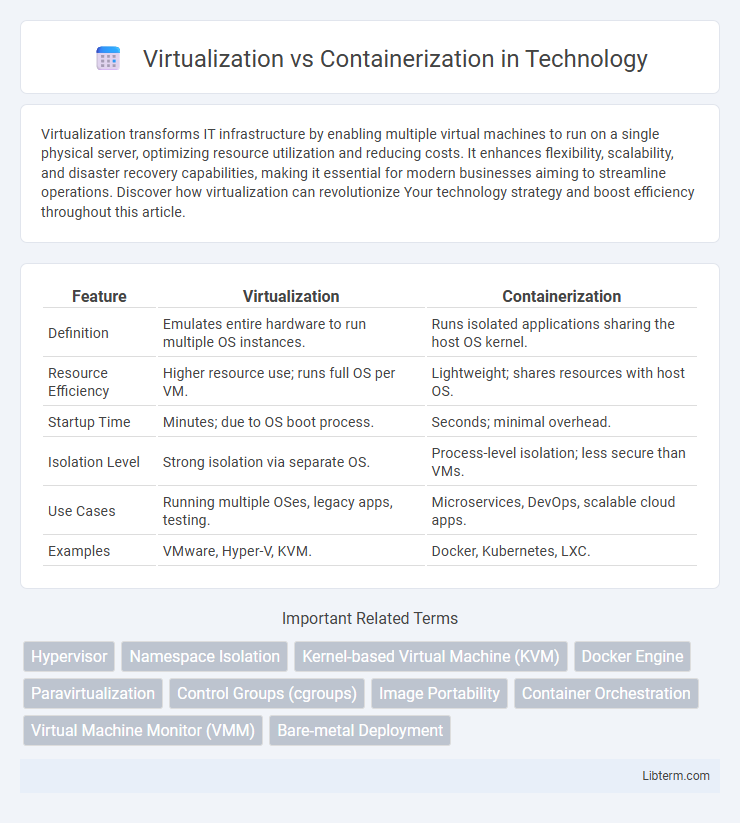Virtualization transforms IT infrastructure by enabling multiple virtual machines to run on a single physical server, optimizing resource utilization and reducing costs. It enhances flexibility, scalability, and disaster recovery capabilities, making it essential for modern businesses aiming to streamline operations. Discover how virtualization can revolutionize Your technology strategy and boost efficiency throughout this article.
Table of Comparison
| Feature | Virtualization | Containerization |
|---|---|---|
| Definition | Emulates entire hardware to run multiple OS instances. | Runs isolated applications sharing the host OS kernel. |
| Resource Efficiency | Higher resource use; runs full OS per VM. | Lightweight; shares resources with host OS. |
| Startup Time | Minutes; due to OS boot process. | Seconds; minimal overhead. |
| Isolation Level | Strong isolation via separate OS. | Process-level isolation; less secure than VMs. |
| Use Cases | Running multiple OSes, legacy apps, testing. | Microservices, DevOps, scalable cloud apps. |
| Examples | VMware, Hyper-V, KVM. | Docker, Kubernetes, LXC. |
Understanding Virtualization: A Brief Overview
Virtualization creates multiple virtual machines (VMs) on a single physical server, enabling resource sharing and isolation at the hardware level through a hypervisor. Each VM runs its own operating system, providing strong security and compatibility but with higher overhead. This contrasts with containerization, which operates at the OS level, allowing lightweight and faster deployment by sharing the host OS kernel.
What is Containerization? Key Concepts
Containerization is a lightweight form of virtualization that packages applications and their dependencies into isolated containers running on a shared operating system kernel. Key concepts include container images, which are immutable snapshots of the application environment, and container runtimes like Docker or containerd that manage lifecycle and resource allocation. This technology enables faster deployment, scalability, and consistency across various computing environments compared to traditional virtual machines.
Virtualization vs Containerization: Core Differences
Virtualization creates multiple virtual machines (VMs) on a single physical server, each with its own operating system, while containerization shares the host OS kernel across isolated containers. Virtual machines require more system resources and longer startup times compared to containers, which are lightweight and start almost instantly. Containers provide application-level isolation, whereas virtualization offers hardware-level isolation, affecting deployment flexibility and resource efficiency.
Performance Comparison: Containers vs Virtual Machines
Containers offer superior performance compared to virtual machines due to their lightweight architecture, sharing the host operating system kernel and requiring fewer resources. Virtual machines require full guest OS instances, leading to higher CPU and memory overhead, which impacts application speed and boot time. Benchmark tests show containers can reduce startup time from minutes to seconds and improve resource utilization efficiency by up to 30%.
Security Considerations in Virtualization and Containerization
Virtualization provides strong isolation by running multiple virtual machines (VMs) on a hypervisor, enhancing security through separate guest operating systems and hardware abstraction. Containerization shares the host OS kernel, which reduces overhead but increases attack surface and potential vulnerabilities due to weaker isolation compared to VMs. Security considerations in virtualization include hypervisor vulnerabilities and VM escape risks, while containerization demands robust namespace isolation, secure image management, and runtime defense against container breakout exploits.
Resource Efficiency: Which Is More Lightweight?
Containerization is more lightweight than virtualization because containers share the host OS kernel, significantly reducing overhead and improving resource efficiency. Virtual machines require a full guest OS, consuming more CPU, memory, and storage resources. This makes containers ideal for high-density deployments and faster startup times in cloud-native environments.
Use Cases: When to Choose Virtualization or Containerization
Virtualization is ideal for running multiple operating systems on a single hardware platform, supporting legacy applications, and ensuring strong isolation for diverse workloads such as development, testing, and production environments. Containerization excels in microservices architectures, continuous integration/continuous deployment (CI/CD) pipelines, and scalable cloud-native applications where lightweight, fast startup, and resource efficiency are critical. Choose virtualization for full OS emulation with robust security, and containerization for rapid deployment and consistent environments across development and production stages.
Scalability and Flexibility: Containers vs Virtual Machines
Containers offer superior scalability compared to virtual machines by allowing rapid deployment and efficient resource utilization at the application level, enabling multiple isolated environments to run on a single OS kernel. Virtual machines provide robust flexibility by supporting different operating systems and full system virtualization, but require more resources and longer boot times, which can limit scalability for large-scale deployments. Containerization streamlines scaling through lightweight, portable units that facilitate microservices architecture, whereas virtual machines excel in scenarios demanding strong isolation and diverse OS support.
Management and Orchestration Tools
Management and orchestration tools for virtualization typically include platforms like VMware vSphere and Microsoft System Center, which manage virtual machines by handling resource allocation, provisioning, and monitoring at the hypervisor level. Containerization relies heavily on orchestration tools such as Kubernetes and Docker Swarm, which automate container deployment, scaling, and networking across distributed environments. These container orchestration systems provide advanced features like self-healing, load balancing, and seamless service discovery, optimizing application lifecycle management in microservices architectures.
Future Trends in Virtualization and Containerization
Future trends in virtualization highlight the rise of lightweight hypervisors and improved hardware-assisted virtualization to enhance performance and security. Containerization is expected to evolve with greater integration of Kubernetes for orchestration, increased adoption of serverless architectures, and enhanced support for multi-cloud environments. Both technologies continue to converge, driving innovation in edge computing, AI workloads, and hybrid cloud deployments.
Virtualization Infographic

 libterm.com
libterm.com